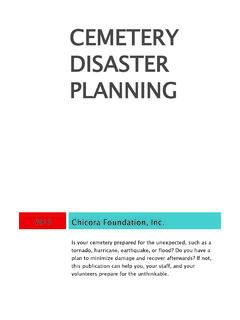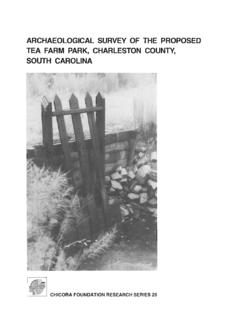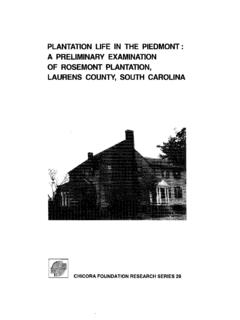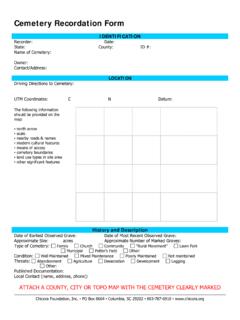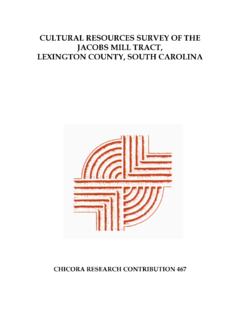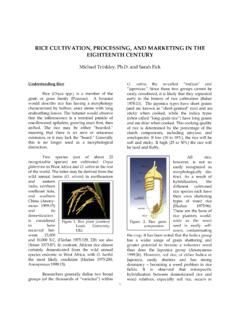Transcription of A PRELIMINARY ARCHAEOLOGICAL CONTEXT FOR …
1 A PRELIMINARY ARCHAEOLOGICAL CONTEXT FOR greenville . COUNTY, SOUTH CAROLINA. Michael Trinkley, , Debi Hacker, and Natalie Adams Introduction This section presents information about the archaeology that has been done in greenville County, the ARCHAEOLOGICAL potential of the county, and the management of these ARCHAEOLOGICAL resources. The vast bulk of ARCHAEOLOGICAL investigations in the county consists of survey level studies in areas to be impacted by highway construction (see, for example, Brockington and Morgan 1987; Caballero 1984; Trinkley 1985).
2 In fact, of the ARCHAEOLOGICAL studies completed by 1990, approximately 83% were done as a part of highway widening or construction (see Derting et al. 1990:248-257). An additional 10% were associated with the placement of sewer lines or other utilities (see, for example, Cable and Michie 1977; Drucker 1979). This leaves only about 7% of the work associated with either development tract survey or data recovery. Unfortunately, unlike areas such as the Savannah River Site, the Richard B. Russell Reservoir, and Sumter National Forest where extensive surveys have taken place, greenville County has not received similar attention, and very little is known about issues such as changing settlement pattern, patterns in lithic resource use, or prehistoric and historic lifeways.
3 As a result, ARCHAEOLOGICAL and historical research from other portions of the state presently must be used to help make predictions about site locations and frame research issues for the county. The most intensive ARCHAEOLOGICAL survey associated with greenville County was performed to assess impacts from the construction of the proposed Laurens-Anderson connector highway from US 276 north of Laurens to US 76 east of Anderson, South Carolina (Goodyear et al. 1979). This study identified a number of historic and prehistoric sites in Anderson, greenville , and Laurens counties.
4 Drawing from resources including the few local surveys, large surveys and excavations in geographically similar areas such as Spartanburg, Laurens, and McCormick Counties, excavations or other studies dealing with technologically similar or identical sites, and historical resources, we will attempt to provide a basic predictive (or perhaps more accurately, projective)1 model for settlement during the different prehistoric and historic time periods. We will also provide information on the " ARCHAEOLOGICAL profile" of site types such as a blacksmith's shop or a tavern.
5 In addition, we will identify some of the more basic and important research questions that need to be addressed for each site type. By reviewing the available data, we can then provide a picture for greenville County's ARCHAEOLOGICAL potential. There are many aspects of the county's past that some people may not have even considered because they associate an ARCHAEOLOGICAL site with recovering artifacts such as ceramics, buttons, bottle glass, etc. However, there is much more to archaeology than these types of artifacts. Archaeology can also recover information regarding technology or construction that only stains in the soil (rather than the more "eye 1 A predictive model uses data available in certain portions of an area and makes predictions on the remaining area.)
6 A projective model uses data from other areas that are then projected onto the study area to make predictions about site locations. With the projective model, it is presumed that settlement models from other areas will hold true in the study area. Alternatively it can be used as a baseline to help explain why settlement is different in the study area. A PRELIMINARY ARCHAEOLOGICAL CONTEXT FOR greenville COUNTY. catching" artifacts). Cultural Phase can provide and can Date Period Piedmont Mountains address questions 1700 such as changing Protohistoric Old Town Qualla technology.
7 It is 1600 hoped that this study Pee Dee will help identify Mississippian Lamar these more obscure Pisgah sources of 1200 Etowah ARCHAEOLOGICAL poten- Napier tial. This information Uwharrie can then be Connestee compared to the rest Cartersville of the state or elsewhere to see how 0 Woodland Yadkin greenville County Pigeon developed similarly Dunlap to or differently than Badin other parts of the Swannanoa state or nation. It can 200 then help to define greenville County's Late Archaic Savannah River cultural identity 4000 through time, by Guilford/MALA helping us Middle Archaic Morrow Mountain understand ques- Stanly tions such as "What 6000 was it like to live in Bifurcate greenville County in Early Archaic Palmer/Kirk 1810, or 1850, or Dalton 1880?
8 " or "What was 8000 it like to be an Indian Simpson/Suwannee living in greenville Paleoindian Clovis County around 1200. Figure 1. Cultural sequence for the South Carolina upcountry. " However, it should be pointed out that greenville County did not exist in a vacuum. This is particularly true for the Native American inhabitants who were much more mobile than the historic people. As a result, questions related to Native American lifeways need to be addressed using a wider regional framework. The management of these ARCHAEOLOGICAL resources is important and should be approached with everyone having the same goal in mind: to identify important sites and to address important questions about greenville County's past so that we can form a picture of how different types of people lived through time.
9 It is helpful, then, to organize resources or potential resources in to "study units" to make ARCHAEOLOGICAL resources more manageable. We can then determine which "study unit(s)" best describe(s) the site (since sometimes more than one study unit is represented) and determine whether or not the site is likely to be able to address the important research issues listed. 2. A PRELIMINARY ARCHAEOLOGICAL CONTEXT FOR greenville COUNTY. The prehistoric section of the report is organized entirely differently than the historic section because of the type of information available.
10 For prehistoric archaeology most of what we know is based on the few ARCHAEOLOGICAL surveys performed in the county or by other studies in the Piedmont region of South Carolina. This section is divided into temporal units such as Paleoindian, Early Archaic, and so on because so little is known about the intricacies of prehistoric life in greenville County or, for that matter, anywhere else in the state (see Figure 1 for an outline of the cultural sequences). The historic section is divided into functional units such as Urban Sites, Gold Mines, Grist Mills, etc.

